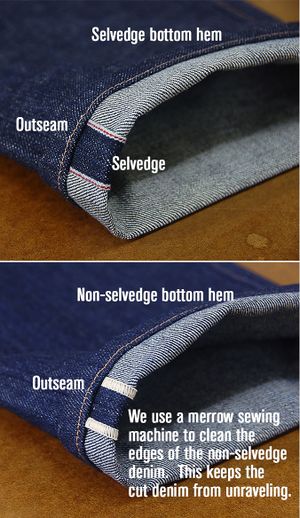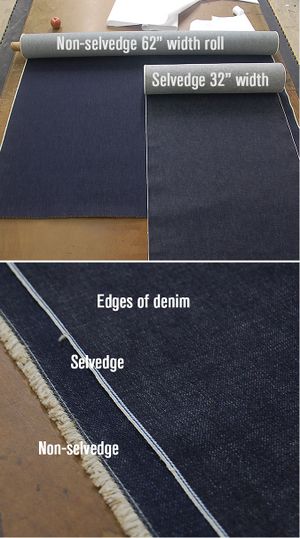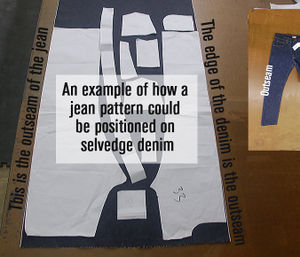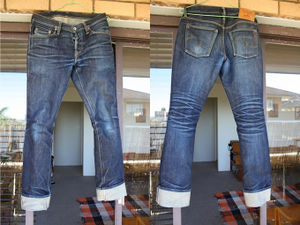Denim 101
Contents
Selvedge and Raw
The two are often confused or conflated for one another, but "raw" and "selvedge" are two fundamentally different properties of denim (and, more broadly, of fabric). "Selvedge" refers to the type of fabric that the jeans are made with, whereas "raw" denotes the unwashed state of the jeans (that is, the jeans haven't been washed after the color treatment process during production). The telltale sign of jeans made with selvedge denim is the so-called "selvedge line" or white taping that runs down the outseam on the inside of a pair of jeans (see pic on right). Raw jeans, on the other hand, can be identified by their uniform, dark indigo color and the stiffness of their fabric.
Raw jeans don't have to be selvedge and selvedge jeans don't have to be raw. Furthermore, neither of these qualities necessarily denotes the quality of the denim. What, then, is the connection between the two and why are they important?
First, let's talk a little more about what selvedge means.
Selvage denim (or Selvedge, Self-edge) is a type of denim made on an old style shuttle loom which creates the unique edge that is typically used on the outseam of jeans. The result is a clean edge where the denim fabric is stitched together that can't be frayed like non-selvage jeans.
The shuttle looms which make selvage denim are smaller and produce a fabric which is narrower than modern, wide projectile looms. Furthermore, the process tends to produce a tighter weave, requiring more material to produce an equivalent yardage. While this makes for a more appealing fabric, it costs more to produce, which is why many denim manufacturers switched to wider projectile looms in the mid to late 1900s.
Nowadays, most jeans are made using fabric produced on wide projectile looms. These looms produce more fabric more quickly and use less cotton per square yard. The fabric doesn't "complete" the way that selvedge fabric does, and thus the outseam needs to be sewn to prevent fraying.
The renewed popularity or raw, selvege denim stemmed from a heritage movement that sought to make jeans with the tools and with the same level of quality that denim lovers expected for decades before modern manufacturing caused a shift to cheap, foreign made denim. As a result, selvedge and raw became standards for high end denim and companies trying to create an authentic product that respected the history of the garment.
Companies have tried to cash in on this trend by producing inexpensive versions of raw or selvedge jeans (most notably Converse and Uniqlo) with mixed results. While being raw and selvedge imparts unique properties to a pair of jeans, the heritage movement has always been about quality, something cheap alternatives simply don't supply.
Likewise, a washed, nonselvedge pair of jeans can be just as good and just as well made as any pair of selvedge or raw jeans. "Selvedge" and "raw" are properties that have become correlated with quality denim, but aren't necessary to it.
Why Buy Raw?
Simple. Buy an unwashed pair of denim and as you wear them more and more you watch the denim progress. Usually with denim like 7 for All Mankind and Rock and Republic, the denim goes through series of washing process to give it a worn look. Raw denim is unwashed before being sold. With wear, the denim loosens and fades which will form to your body. With every wear, creases will form and eventually indigo rubs off. The color will fade creating patterns. This is typical in higher stress areas such as whiskers (upper thigh creases), honeycombs (behind the knee creases), and down the thigh to the knee. You are creating what is seen on a typical wash on many designer jeans (since many washes try to mimic a natural fade).
Sizing
There's a lot of confusion about sizing for raw denim. You might have heard to size up, size down, and/or to buy tts. In general you're going to be sizing down. The exception to this is unsanforized denim (scroll down for more information on sanforized jeans). Unless otherwise specified, jeans will be made with sanforized denim. The question, then, is how much to size down?
The first step in selecting a waist size is to actually (and this will help with buying any other pants) measure your waist. Just get a bit of string and wrap it around your waist where you expect the waist of the jeans to rest. Don't pull it tight, though. Lay out the string and measure the length that corresponds to your waist. Don't be surprised if the measurement is 2-4 inches more than what you normally wear. In the US, a 3" vanity size "buffer" isn't unusual.
It's important to know your actual waist size because the size listed on the tag could be off by anywhere between a half inch to several inches. Most serious jean retailers will list the tag size as well as the actual measured waist of a pair of jeans. Take, for example, these 3sixteens. A 30" waist is actually 31 inches, which is a mild deviation, especially compared to a company like APC, which is known for vanity sizing. Selfedge also notes how long it'll take for the waist to stretch and about how much it will stretch, which is a nice addition.
So, now that you know your waist size, you can narrow in on the size you want. Some people like to buy true to size--whatever is closest to their actual measurements--while others like to size down (usually between 1-3 sizes) to take into account how much the jeans are liable to stretch over time. How much you size down depends on the particular jean (some brands tend to stretch more than others) and how you'd like the jean to end up fitting (skinny, slim, or otherwise). There's no standard measure so you have to do your own research.
Sanforization
Sanforization is a process of shrinking and fixing a woven cloth in both length and width before being made into a garment and has no effect on the color or quality of the finished product. When denim is sanforized it's "preshrunk".
Sanforized raw jeans will still shrink in warm water (particularly after being stretched through wear), but far less so than unsanforized denim. Most denim nowadays is sanforized so when you finally wash your jeans they shouldn’t shrink that much. Some Japanese denim manufactures like Flat Head and Iron Heart, however, specialize in unsanforized jeans, and Levi's 501 STF (Shrink-to-Fit™) jeans are unsanforized as well. Unsanforized denim should generally be soaked before wearing, that way you won't have uneven fades when you eventually wash them, and so you don't look like an idiot wearing oversized jeans.
Unsanforized jeans (unlike their sanforized raw counterparts) are often purchased true to size in the waist or larger to account for this shrinkage. It's a personal choice, but I've found tts to work fine for both sanforized and unsanforized jeans.
The basic method for shrinking unsanforized jeans is to submerge in hot water inside out for an hour or two and then hang dry. Some methods say to wear the jeans in the tub (not inside out in this case) to allow them to mold to your body, and yet others say to wear the jeans as they dry to encourage them to conform to your body.
Indigo Staining
Under certain conditions, raw jeans can transfer indigo dye onto other clothes and upholstery. Different jeans will bleed to different extents but generally speaking, rough or repeated physical contact with light colored items, or contact with wet or damp light colored items will encourage color transfer. Be careful wearing whites and light colored shoes (canvas and even suede) with raw jeans. Cuffing can reduce the chance of color bleeding onto your shoes, though. I've even heard of people taping the inside of their pants to prevent staining, but this is a pretty extreme measure. Wet items will pick up indigo very easily, however. I once rinsed a white shirt to remove a stain only to have it stained blue where it came in contact with my jeans. Needless to say, wear something else if there's rain in the forecast.
Altogether, staining isn't a tremendous concern, but is something to be aware of. If it does concern you that much, consider soaking your raw jeans before wearing them. An initial soak will remove some of the excess dye and starch left over from the production process and shouldn't affect fading much later on.
If you do stain your clothing with indigo, try using saddle soap or Fels-Naptha (which I've personally had success with) to wash it out. And, as with any stain, work quickly if possible, and don't allow the stain to dry and set in.
Washing & Soaking
The rule of thumb (if you're looking for pronounced or high contrast fading) is to wait at least 6 months to wash raw jeans. This is just a guideline, though. If you sit around in your raws all day posting on /fa/, it'll take longer to get fades than someone who's moving about a lot. Your best option is pay attention to how the jeans are fading by themselves. With wear you'll notice highlights around creases or stress points. When you start to see noticeable fading along the whiskers (creases around the crotch) and honeycombs (creases behind the knee), it might be time to wash your jeans.
The basic method of washing them is rather simple: fill a tub with room temperature water, add in a color safe detergent like Woolite Black, turn the jeans inside out, lay them flat in the tub, gently submerge for 1-2 hours, rinse with cold water, and then hang dry.
If you don't care about fades or dye loss, you should still line dry and wash with care. Dryers can cause unfavorable shrinkage and change the look of the fabric.
If your jeans start to stink from excessive wear, Febreeze and an extended line dry can help. One thing that doesn't work: the infamous freezer method. Freezing your jeans might seem to get rid of the smell temporarily, but it'll be back (and pretty quickly).
Hemming
Raw denim usually comes with very long inseams. If they're longer than you want, you can simply have them hemmed (this will cost anywhere between $5-25 depending on the tailor and the type of hem). Remember that even if your jeans are sanforized you might still see some shrinkage when you wash (in some cases up to 2" in length). Some people recommend waiting until after the first wash to hem their jeans, but honestly you can just have them hemmed and leave yourself a little wiggle room (say, take the seam down to a 32" if what you really want is a 30"). Washing in cold water and line drying will further reduce the chances of unwanted shrinkage.
Some people like the extra inseam, though, to cuff or create mad stacks. Ultimately it's personal preference.
A List of Recommended Brands
Under $100
- H&M*
- GAP*
- Uniqlo*
- Levis*
- Cheap Monday*
- Unbranded $78+, Made in Macau of Japanese denim
- J.Crew* $96+
- Bluer $98+ check out their Home Try-On option, Made in the USA
- Gustin $99, Made in SF, USA of Japanese denim
(*Generally not raw or selvedge)
$100-200
- Williamsburg Garment Company $105+, Made in the USA and imported styles, Japanese denim
- April 77 $130+
- United Dry Stock Goods $135+ Made in USA of Japanese denim
- Naked and Famous $135+ ; Made in Canada, Japanese denim (Gilt often sells them for $89)
- Left Field NYC $175+ ; Made in the USA, Cone Mills denim
- Nudie $179+ made in Italy, denim from Italy, Japan, and Turkey
- APC $185+ Made in Macau, Japanese denim
- BLK DNM $190+
$200-300
- Edwin $200+ Made in Japan, Japanese denim
- ACNE $200+ Made in Turkey, Italy, Albania
- Rogue Territory $210+; Made in the USA; Nihon Menpu Mills denim, Cone Mills denim
- 3sixteen $215+ made in USA, Kuroki Mills denim, Japanese Denim
- Tellason $220+ made in USA, Cone Mills denim
- Levi's Vintage Clothing $250+ (for 501xx) Cone Mills denim, Made in USA
- Pure Blue Japan $275 Made in Japan, Japanese denim
$300&UP
- Momotaro $315+ Made in Japan, Japanese denim
- Roy $335+ Made in USA, Cone Mills denim
- Samurai $345+ Japanese denim, Made in Japan
- Iron Heart $360+ Made in Japan, Japanese denim
- Flat Head $335 Made in Japan, Japanese denim
- Dior $390+
- Saint Laurent $400+
Resources and Retailers:
Info
What is Selvedge Denim? a visual run down of selvedge and how it differs from non selvedge.
Rawr Denim, a great resource. Check out their "fade friday."
Selvedge Myth Busting. Take this info with a grain of salt.
Scout Rawr Denim's "Scout" service. Useful for finding specific kinds of denim and exact measurements.
Shops
Tate + Yoko (Canada)
Superdenim (UK)



